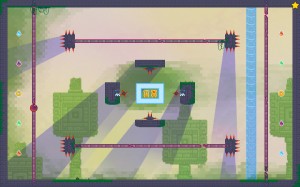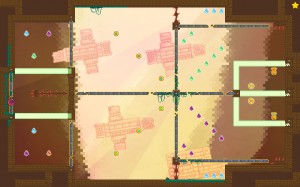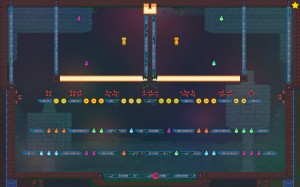Game:
Paragon
Developer:
Release Date :
2014
Platform:
PC
Reviewed on PC

Before I review the up-coming indie game Paragon, here’s a brief message from Developer Mike Lasch:
“Working on Paragon has been a great labor of love over these past three years, and I think we were able make it something really special. James Shasha’s pixel art and Ex Machinae’s layered music do a great job of emphasising the unique gameplay, and I’m really proud of how the game has come together. I hope everyone who downloads Paragon agrees!”

In Paragon you control a bouncing ball that bounces diagonally across surfaces until it reaches a magnetic rail. It then continuously runs back and forth or up and down along the rail until you decide to leave the track with the arrow keys. Interesting for me is that the more items you collect and the further you progress you unlock more sound/music modifiers and other effects.
With the sound design I really like the stereo panning that works across the levels. If you’re on the left hand side the item collect noises and bouncing sounds are panned left and move around the level as you do. It is a simple touch, but I really enjoy it and to be honest I think simple panning is often neglected so it made me smile! The sounds are very basic but have the weight behind them to set it apart from what I like to the usual blips and boops.
The first thing I like about the audio is the how big it feels. On the start screen the music creates a sense of an intense epic. It really does raise the tension involved whilst figuring out when to press that arrow key to send your ball to find treasure or death. Throughout the levels the music sounds very oppressive and industrial, with nice and heavy drum beats, some heavy guitar riffs as well as evil synths. I feel this gives the game another element of personality and gives a dark element to the game, which I’m personally bias for.

Musically this game is also very clever. The more items you collect the more layers get added to the music. Every few items you collect, more parts are added to the current piece. It may start as a basic synth melody, then as the items are collected other instruments,such as a deep bass synth and hi-hats, are added.
I highly recommend experiencing Paragon to fully enjoy the audio splendour it holds.
We asked Sound Designer and Composer for the project, Ex Machinae ,AKA Phil Petrie, about the audio for Paragon:
What brief were you given?
As independents, we were able to talk out a lot of what we wanted. I knew that the goal was a game with music that changed based on what was happening in the game, and with sound effects that would tie in to the music; something really immersive. Mike put together a proof of concept using multitrack files for the Social Network soundtrack (Trent Reznor & Atticus Ross). We’d both been listening to that particular release a lot lately, and thought that the vintage minimalism together with darker atmospherics would work well with the game. This is a remake of an older game, and Mike knew he wanted the design to reflect that somehow. I suggested some chiptune sounds and he agreed. Those ideas were the brief, I suppose.

What was your first step in the process?
The first step for me was the construction of percussive elements. I always start there. I knew that I wanted something to sound both new and old at the same time. I took a lot of acoustic percussion samples and machine noises and granulized them. Stretching them and stuttering them. I’d just record myself twisting knobs until I thought I had a few interesting noises happening. Then I’d go back through the recording and just take out little slices. No more than a few milliseconds. I’d use lower noises for kick drums, mids for snares, and highs for hats and cymbals. I knew the beat would be the most constant element, so it needed to be immediately accessible and still be interesting after 100 hours of playing. I think these floppy organic/mechanic sounds helped balance that.
Where did you draw your inspiration from?
Throughout my work NIN is an influence, and Trent’s soundtrack work specifically for this project. Aphex Twin was a big influence for the percussive elements. I’d also been listening to a lot of early synth stuff. David Bowie’s Low, Visage, Ultravox. Paragon has a kind of scratchy lo-fi sound, that’s where it comes from.
What software and plug-ins do you use?
I’m a long time FL Studio and Reaper user. FLStudio just fits the way my brain works when it comes to composition. And Reaper is the most flexible DAW on the market if you ask me. For synths I tend towards freeware. The one that’s easiest to recognize on this release is Quantum64, a free Commodore 64 SID emulator. So many great video game noises with this little guy. Used if for a lot of the sound effects, too.

Any middleware?
Nope. The implementation was fairly straightforward for a game like this. Very musical and not many environmental sounds to keep track of or manipulate.
What were the main challenges you faced with the sound design and/or music for Paragon?
My goal was to create something that you could sit down and listen to outside of the game; something really engaging. But you have to be careful with that because it has to sit well in the game. If you make something that’s all over the place, that can be really fun for a listener the first time around. But loop it 20 or 30 times and that intensity just becomes tiring. Counter-intuitively, I think that something a little more repetitive and minimalist can take you farther, because it puts the listener at ease and let’s them settle into a groove.
Keep up to date with Ex Machinae here at the official site: http://exmachinae.com/
Paragon is going to be available soon so keep up to date with Mike’s development at these links:
Twitter: @BipolarMike
YouTube: http://youtube.com/user/bipolarmike
Website: http://j.mp/BipolarDesign
I hope you enjoyed my review!
Review by Sam Hughes
Uploaded 12/01/14

